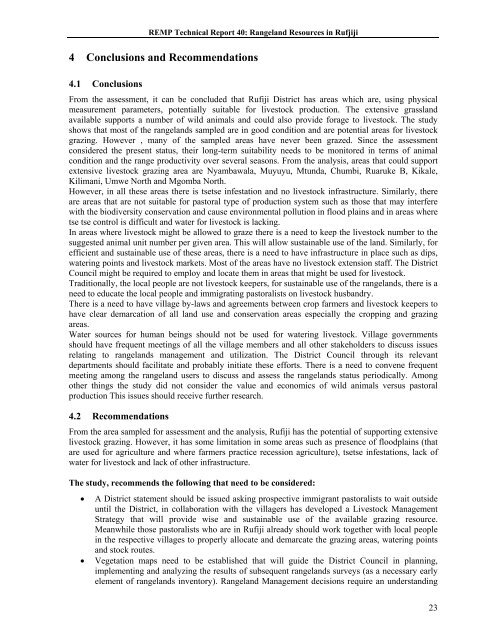rufiji environment management project - Coastal Forests of Kenya ...
rufiji environment management project - Coastal Forests of Kenya ...
rufiji environment management project - Coastal Forests of Kenya ...
You also want an ePaper? Increase the reach of your titles
YUMPU automatically turns print PDFs into web optimized ePapers that Google loves.
REMP Technical Report 40: Rangeland Resources in Rufjiji<br />
4 Conclusions and Recommendations<br />
4.1 Conclusions<br />
From the assessment, it can be concluded that Rufiji District has areas which are, using physical<br />
measurement parameters, potentially suitable for livestock production. The extensive grassland<br />
available supports a number <strong>of</strong> wild animals and could also provide forage to livestock. The study<br />
shows that most <strong>of</strong> the rangelands sampled are in good condition and are potential areas for livestock<br />
grazing. However , many <strong>of</strong> the sampled areas have never been grazed. Since the assessment<br />
considered the present status, their long-term suitability needs to be monitored in terms <strong>of</strong> animal<br />
condition and the range productivity over several seasons. From the analysis, areas that could support<br />
extensive livestock grazing area are Nyambawala, Muyuyu, Mtunda, Chumbi, Ruaruke B, Kikale,<br />
Kilimani, Umwe North and Mgomba North.<br />
However, in all these areas there is tsetse infestation and no livestock infrastructure. Similarly, there<br />
are areas that are not suitable for pastoral type <strong>of</strong> production system such as those that may interfere<br />
with the biodiversity conservation and cause <strong>environment</strong>al pollution in flood plains and in areas where<br />
tse tse control is difficult and water for livestock is lacking.<br />
In areas where livestock might be allowed to graze there is a need to keep the livestock number to the<br />
suggested animal unit number per given area. This will allow sustainable use <strong>of</strong> the land. Similarly, for<br />
efficient and sustainable use <strong>of</strong> these areas, there is a need to have infrastructure in place such as dips,<br />
watering points and livestock markets. Most <strong>of</strong> the areas have no livestock extension staff. The District<br />
Council might be required to employ and locate them in areas that might be used for livestock.<br />
Traditionally, the local people are not livestock keepers, for sustainable use <strong>of</strong> the rangelands, there is a<br />
need to educate the local people and immigrating pastoralists on livestock husbandry.<br />
There is a need to have village by-laws and agreements between crop farmers and livestock keepers to<br />
have clear demarcation <strong>of</strong> all land use and conservation areas especially the cropping and grazing<br />
areas.<br />
Water sources for human beings should not be used for watering livestock. Village governments<br />
should have frequent meetings <strong>of</strong> all the village members and all other stakeholders to discuss issues<br />
relating to rangelands <strong>management</strong> and utilization. The District Council through its relevant<br />
departments should facilitate and probably initiate these efforts. There is a need to convene frequent<br />
meeting among the rangeland users to discuss and assess the rangelands status periodically. Among<br />
other things the study did not consider the value and economics <strong>of</strong> wild animals versus pastoral<br />
production This issues should receive further research.<br />
4.2 Recommendations<br />
From the area sampled for assessment and the analysis, Rufiji has the potential <strong>of</strong> supporting extensive<br />
livestock grazing. However, it has some limitation in some areas such as presence <strong>of</strong> floodplains (that<br />
are used for agriculture and where farmers practice recession agriculture), tsetse infestations, lack <strong>of</strong><br />
water for livestock and lack <strong>of</strong> other infrastructure.<br />
The study, recommends the following that need to be considered:<br />
• A District statement should be issued asking prospective immigrant pastoralists to wait outside<br />
until the District, in collaboration with the villagers has developed a Livestock Management<br />
Strategy that will provide wise and sustainable use <strong>of</strong> the available grazing resource.<br />
Meanwhile those pastoralists who are in Rufiji already should work together with local people<br />
in the respective villages to properly allocate and demarcate the grazing areas, watering points<br />
and stock routes.<br />
• Vegetation maps need to be established that will guide the District Council in planning,<br />
implementing and analyzing the results <strong>of</strong> subsequent rangelands surveys (as a necessary early<br />
element <strong>of</strong> rangelands inventory). Rangeland Management decisions require an understanding<br />
23

















